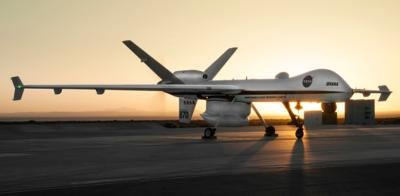Aircraft To Monitor Return Of Orion From First Flight Test
A number of teams will have eyes, cameras and telescopes trained on the skies for the splashdown of the first flight of NASA's Orion capsule — with the help of Navy and NASA aircraft.

The SCIFLI (Scientifically Calibrated In-Flight Imagery) team, based at NASA's Langley Research Center in Hampton, Virginia, is preparing to capture thermal snapshots of the super hot re-entry of Orion into Earth's atmosphere following its first test flight. The uncrewed capsule is scheduled to launch no earlier than Dec. 4 at 7:05 a.m. ET atop a Delta IV Heavy rocket from Cape Canaveral Air Force Station's Launch Complex 37 in Florida. Orion will travel to an altitude of 3,600 miles — 15 times higher than the International Space Station — orbit Earth twice, then splash down in the Pacific Ocean four and a half hours later and be recovered.
"This is going to be a tough one. Orion will come through the atmosphere at 20,000 miles an hour as a tiny dot in the sky. With the capsule initially hundreds of miles away, it is like we are looking for it through a small soda straw," said Tom Horvath, SCIFLI principal investigator. "It's all about getting the aircraft positioned at the right location at a precise point in time. The action will be in the last minute. Temperatures will go from very low to up to 4,000 degrees Fahrenheit."
The team will use a U.S. Navy NP-3D aircraft, also called Orion, to capture the imagery. It is equipped with a long-range infrared optical system called "Cast Glance." The NP-3D Orion is one of five operated by the NAVAIR Weapons Division's Air Test and Evaluation Squadron-30 (VX-30), Pt. Mugu, California. The research effort is sponsored by the NASA Engineering and Safety Center.
After the team has confirmation of the launch, the aircraft will fly from its base in Pt. Mugu to the desired observation location over the Pacific Ocean, 200-300 miles from California's Baja Peninsula. Once the aircraft reaches a point about 25 miles away from the Orion's projected entry trajectory, it continues flying in a sort of race track pattern until the capsule enters the atmosphere and emits enough thermal energy for the plane's infrared cameras to catch a glimpse. Then the crew will scramble to take images as Orion descends at hypersonic speeds. The SCIFLI team will have personnel inside the Mission Control Center in Houston and at Pt. Mugu to support and coordinate aircraft operations.
"We want to determine how hot the Orion heat shield gets during re-entry, then compare that data against the thermocouple sensors that are embedded in the capsule's shield," said Horvath. "The infrared camera may also permit us to observe rapid increases in surface temperature. These temperature jumps, generated by surface roughness on the capsule heat shield, are difficult to predict.”

"These observations of exterior temperatures will help reduce uncertainty in our computer models," said Orion Systems Engineer Gavin Mendeck at NASA's Johnson Space Center in Houston. "We think we are conservative, but this real-life data will help us understand just how conservative."
Another Navy NP-3D Cast Glance aircraft, sponsored by the Orion program, will also follow the water landing with cameras, but looking more at the descent — especially the parachutes. "We want to verify and document how the parachutes perform," said Mendeck. "The first chutes — the drogues — deploy at an altitude of 22,000 feet." The two drogue chutes are used to slow the capsule down and stabilize it. They get released, then three massive main parachutes deploy to slow Orion down to less than 20 miles an hour for a safe splashdown in the Pacific Ocean.
Two Navy MH-60S Knighthawk helicopters, out of the Helicopter Sea Combat squadron #8 (HSC-8) based out of the Naval Air Station North Island in San Diego, equipped with still, video and handheld infrared cameras will also be on hand to observe the last 10,000 feet of Orion's first journey. They are supporting the San Diego Naval Station-based Amphibious transport dock, USS Anchorage (LPD-23), which will recover the spacecraft.
And one more aircraft — the remotely piloted Ikhana/ MQ-9 Predator B, based at NASA's Armstrong Flight Research Center at Edwards, California, will fly its own race track pattern to the south of Orion's projected entry trajectory. It will provide live video of the splashdown for NASA TV.
(Images provided by NASA)
 Senator Pushes FAA to Accelerate Rocket Launch Licensing
Senator Pushes FAA to Accelerate Rocket Launch Licensing Classic Aero-TV: RJ Gritter - Part of Aviations Bright New Future
Classic Aero-TV: RJ Gritter - Part of Aviations Bright New Future Aero-FAQ: Dave Juwel's Aviation Marketing Stories -- ITBOA BNITBOB
Aero-FAQ: Dave Juwel's Aviation Marketing Stories -- ITBOA BNITBOB ANN's Daily Aero-Linx (10.27.24)
ANN's Daily Aero-Linx (10.27.24) ANN's Daily Aero-Term (10.27.24): Clearance Void If Not Off By (Time)
ANN's Daily Aero-Term (10.27.24): Clearance Void If Not Off By (Time)




